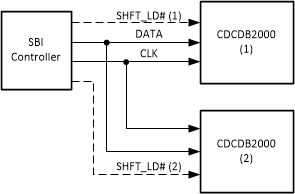ZHCSKG8B November 2019 – October 2024 CDCDB2000
PRODUCTION DATA
6.5.2 SBI
Side-Band Interface (SBI) is a simple 3-wire serial interface. This interface consists of DATA, CLK and SHFT_LD# pins. When the SHFT_LD# pin is high, the rising edge of CLK clocks DATA into a shift register. After shifting data, the falling edge of SHFT_LD# loads the shift register contents into the Output Register. Both the SBI and the traditional SMBus interface feed common output enable/disable synchronization logic, which ensures glitch-free enable and disable outputs regardless of the method used.
SBI can be configured at a system level in three ways: star topology, daisy chain topology, and directly. The star topology is shown in Figure 6-3. The daisy chain topology is shown in Figure 6-4.
 Figure 6-3 SBI Star
Topology
Figure 6-3 SBI Star
Topology Figure 6-4 SBI Daisy
Chain Topology
Figure 6-4 SBI Daisy
Chain Topology